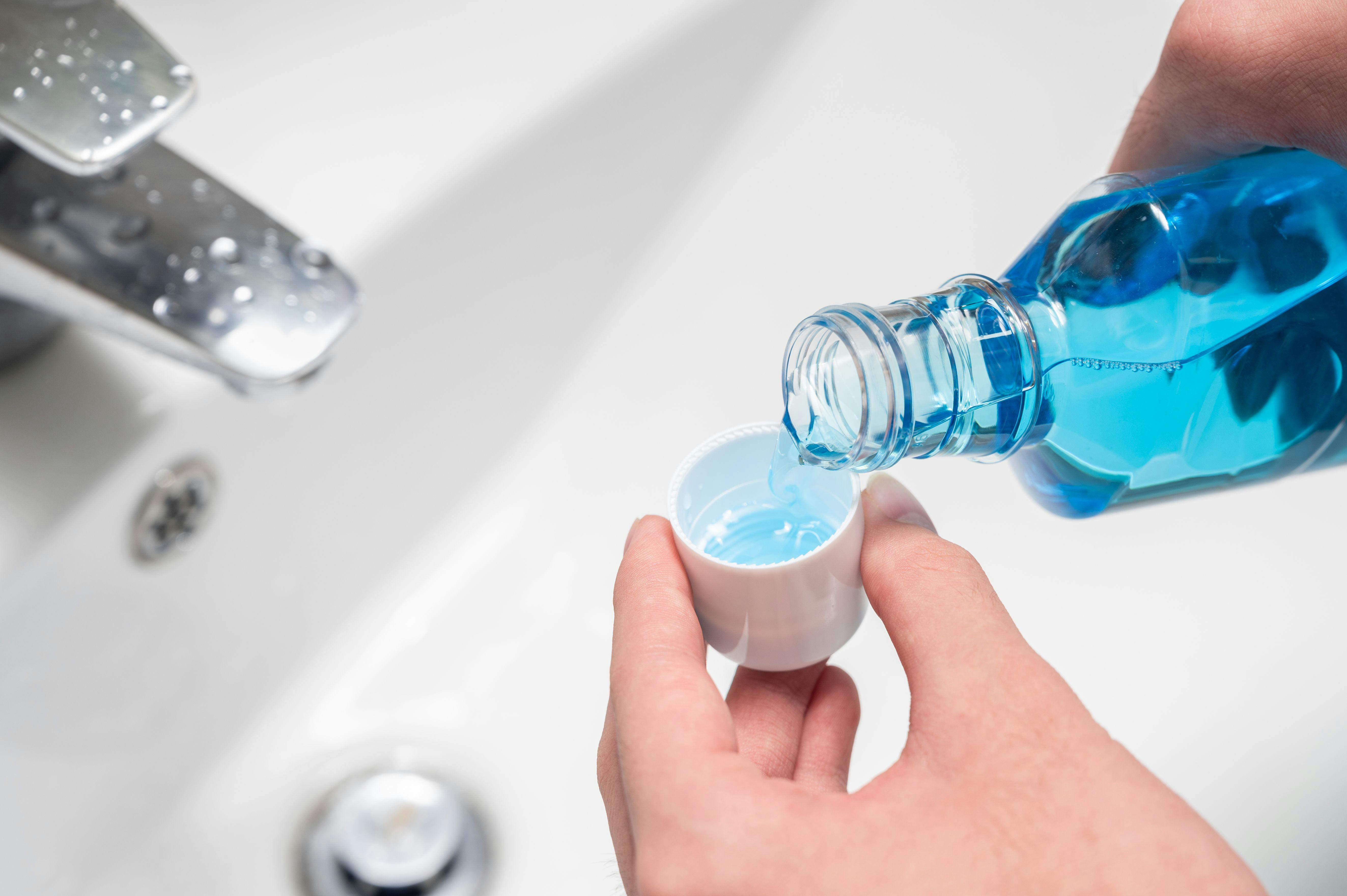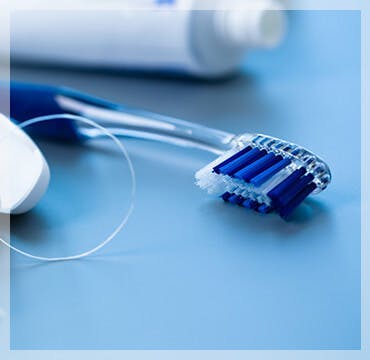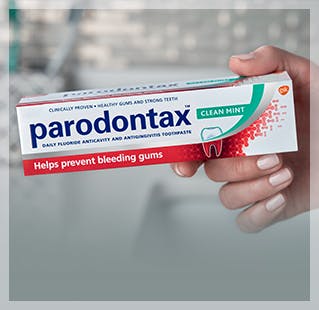Is mouthwash a part of your daily oral hygiene routine? If you don’t already use it, it may not be a bad idea to start. Mouthwash is commonly known as a temporary cure for bad breath, but using a rinse with the right ingredients can be beneficial for your oral health. Mouthwashes that contain anti-bacterial ingredients are especially helpful if you’re looking to improve your gum health. Your gums serve as a strong foundation for your teeth and should be treated with as much care as possible.
When paired with good brushing habits, swishing a dose of mouthwash for a few seconds is a quick way to make a difference for your gums and overall oral health. Read on to learn more about using mouthwash for your gums and keeping your mouth healthy.

Why Is it Important to Maintain Healthy Gums?
Gums are the tissues along the bone that hold your teeth in place to support a healthy smile.1 A thin, sticky film of bacteria called plaque can damage your teeth and gums if it is not routinely removed.1 Plaque is constantly growing in your mouth, which is why it is important to brush and clean between your teeth every day to keep it from building up.1 Plaque buildup can eventually harden into tartar, and when tartar forms above and below the gum line it becomes harder to clean your teeth.2 Tartar can only be removed by a professional cleaning from a dentist or dental hygienist.2
Plaque and tartar buildup can cause gingivitis, which is a mild form of gum disease.1 Your gums may appear red and swollen and can bleed easily if you have gingivitis.3 Gingivitis can be reversed through professional cleanings, twice daily brushing, and interdental flossing, but it can progress to a more advanced stage of gum disease called periodontitis if left untreated.3 Periodontitis can lead to the loss of tissue and bone that support the teeth.3 Chronic periodontitis, which affects 47.2% of adults over 30 in the United States, gets worse slowly with potential periods of rapid progression.3
How Can Mouthwash Protect Against Gum Disease?
Mouthwash (also known as mouthrinse) comes in two different formulations: cosmetic and therapeutic.4 Cosmetic mouthwashes only work to temporarily reduce bad breath and leave a pleasant taste in your mouth, but therapeutic mouthwashes contain active ingredients that kill bacteria and can help reduce gingivitis, cavities and bad breath.4 Some therapeutic mouthwashes have fluoride in them to help prevent or reduce tooth decay.4 Therapeutic mouthwashes are helpful because they can get in between your teeth, just like dental floss or other interdental cleaners.4 They can reach areas of your mouth that your toothbrush can’t get to and help reduce the risk of cavities and gum disease.4 Many therapeutic mouthwashes require a prescription from a healthcare provider, depending upon the active ingredients. There are a number of therapeutic mouthwashes that can be purchased over-the-counter at your local market or pharmacy
Mouthwash should not be used as a replacement for daily brushing and flossing, but it can be a beneficial addition to your oral health routine.4 A mouthwash with the right active ingredients can be used to control plaque and reduce the speed that tartar forms on your teeth. To find the best mouthwash for you, check with your healthcare provider.
What Active Ingredients in Mouthwash Can Help Gums?
Before trying a new mouthwash, check the label to see what active ingredients are used in the formula. Active ingredients that can be found in therapeutic mouthwashes are cetylpyridinium chloride, chlorhexidine, essential oils, fluoride and peroxide.5 Of these ingredients, cetylpyridinium chloride, chlorhexidine and essential oils are known to help reduce plaque and gingivitis when combined with daily brushing and flossing.5 All three of these antimicrobial ingredients may also be effective for long-term control of bad breath.5 Although some studies have found that chlorhexidine is better for controlling plaque than essential oils, both ingredients are equally effective in regards to gingivitis control.5
Many over-the-counter therapeutic mouthwashes are available for improving gum health. However, products containing chlorhexidine can only be obtained with a prescription.5 Talk to a dental health professional about using chlorhexidine and whether it’s right for you.
When Should I Use Mouthwash?
Whether you choose to use mouthwash before or after brushing is a matter of preference.5 However, some toothpaste ingredients may interact with mouthwash and make them less effective. Rinsing vigorously with water after brushing can remove toothpaste from your mouth and allow your mouthwash to work properly.5 Using mouthwash after brushing is also believed to rinse away fluoride, which is an important ingredient that is found in most toothpastes.6 Fluoride strengthens the tooth enamel and makes your teeth more resistant to decay.6 In order to get the full benefits of fluoride, use mouthwash at a separate time than brushing.6
Children under the age of six should not use mouthwash.4 They may accidentally swallow large amounts of mouthwash, which can cause nausea, vomiting and intoxication (if the mouthwash contains alcohol).4 It is important to check with your dental professional prior to allowing a child under 6 to use a mouthwash.
Try Mouthwash for Gum Health
If you’re looking to get a mouthwash for gums, choose one from an oral health brand that specializes in gum health, like parodontax. The all-new parodontax Active Gum Health Mint Mouthwash helps prevent gingivitis and creates an anti-bacterial shield in your mouth after use. This alcohol-free formula contains cetylpyridinium chloride to kill 99.9% of plaque bacteria and germs that cause bad breath.* ^ You can also try the Clear Mint mouthwash, which is dye-free.
And remember, mouthwash is not a substitute to brushing. Find more helpful products and tips for gum health on the parodontax page.
*bacteria associated with gingivitis in a laboratory test
^in a laboratory test
Source Citations:
- Keeping your gums healthy. The Journal of the American Dental Association. https://jada.ada.org/article/S0002-8177(15)00245-7/fulltext Accessed 6/9/2022.
- Periodontal (Gum) Disease. National Institute of Dental and Craniofacial Research. https://www.nidcr.nih.gov/health-info/gum-disease Accessed 6/9/2022.
- Gum Disease. American Dental Association. https://www.mouthhealthy.org/en/az-topics/g/gum-disease Accessed 6/9/2022.
- Mouthwash. American Dental Association. https://www.mouthhealthy.org/en/az-topics/m/mouthwash Accessed 6/9/2022.
- Mouthrinse (Mouthwash). American Dental Association. https://www.ada.org/resources/research/science-and-research-institute/oral-health-topics/mouthrinse-mouthwash Accessed 6/9/2022.
- “Spit don’t rinse” for better oral health. Oral Health Foundation. https://www.dentalhealth.org/news/spit-dont-rinse-for-better-oral-health Accessed 6/9/2022.





